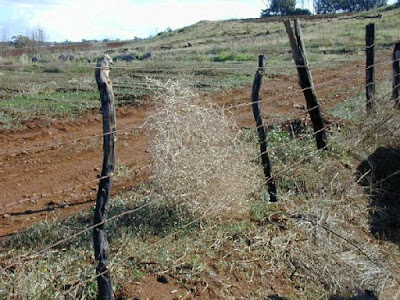Ironmonger Lucien Smith of Kent, Ohio patented the first artificial thorn hedge on June 25, 1867. It is better known today as barbed wire.
Joseph Farwell Glidden, a DeKalb, Illinois farmer invented a method for mass manufacturing of barbed wire in 1873. It was cheap to produce and easy to put up and Glidden made a fortune as miles of his wire criss-crossed American farms. It was the beginning of the end of open range in the west.
In 1876 commercial production was 1,500 tons (1,361 tonnes) and by 1900 annual barbed wire production had reached 200,000 tons (181,437 tonnes). By 1910 wooden fences had almost disappeared.
Joseph Farwell Glidden, a DeKalb, Illinois farmer invented a method for mass manufacturing of barbed wire in 1873. It was cheap to produce and easy to put up and Glidden made a fortune as miles of his wire criss-crossed American farms. It was the beginning of the end of open range in the west.
In 1876 commercial production was 1,500 tons (1,361 tonnes) and by 1900 annual barbed wire production had reached 200,000 tons (181,437 tonnes). By 1910 wooden fences had almost disappeared.
The widespread use of barbed wire in the United States in the late 19th century enabled improvements in cattle breeding and ranching. It became more affordable to fence much larger areas than before, and intensive animal husbandry was made practical on a much larger scale.
Barbed wire was used for military purpose the first time in the Spanish-American War during the siege of Santiago by the Spanish defenders.
Horses panic easily, and once caught in barbed wire, large patches of skin may be torn off. For this reason barbed wire was the single most important factor in rendering the U.S. Cavalry ineffective and led to the cavalry's eventual dismantling.
Barbed wire was used extensively by all participating combatants in World War I to prevent movement, with deadly consequences. Barbed wire entanglements were placed in front of trenches to prevent direct charges on men below, increasingly leading to greater use of more advanced weapons such as high powered machine guns and grenades.
The Devil’s Rope Museum in Texas is a museum of barbed wire, housed in an old brassiere factory.
The Kansas Barbed Wire Museum has 2,000 varieties of barbed wire.
Source foodreference.com, Wikipedia
Barbed wire was used for military purpose the first time in the Spanish-American War during the siege of Santiago by the Spanish defenders.
Horses panic easily, and once caught in barbed wire, large patches of skin may be torn off. For this reason barbed wire was the single most important factor in rendering the U.S. Cavalry ineffective and led to the cavalry's eventual dismantling.
Barbed wire was used extensively by all participating combatants in World War I to prevent movement, with deadly consequences. Barbed wire entanglements were placed in front of trenches to prevent direct charges on men below, increasingly leading to greater use of more advanced weapons such as high powered machine guns and grenades.
The Devil’s Rope Museum in Texas is a museum of barbed wire, housed in an old brassiere factory.
The Kansas Barbed Wire Museum has 2,000 varieties of barbed wire.
Source foodreference.com, Wikipedia


No comments:
Post a Comment